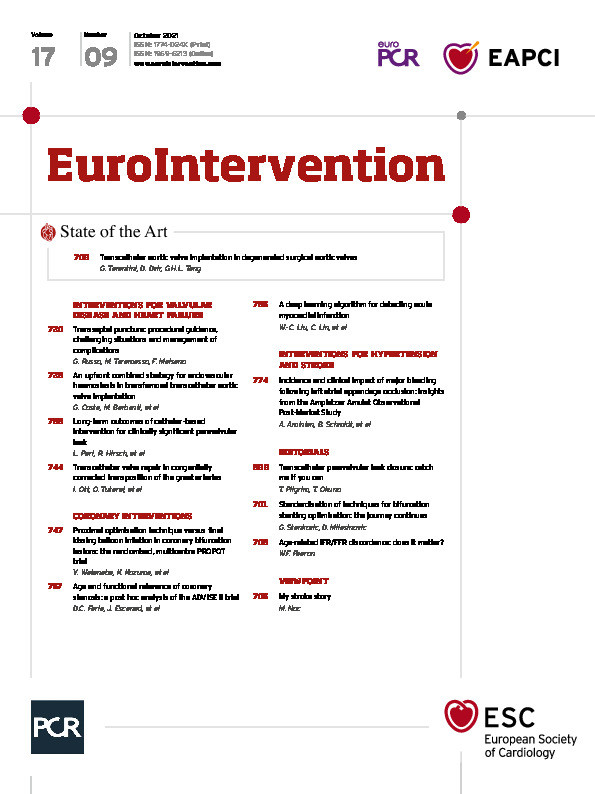The relationship between microvascular dysfunction and fractional flow reserve (FFR) has long been recognised1. Microvascular dysfunction results in a lower maximal achievable flow down a coronary artery, a lower pressure gradient and a higher FFR across a given stenosis. Some have argued that this represents an underappreciation by FFR of the functional significance of a stenosis. However, De Bruyne and colleagues demonstrated that, in the presence of microvascular dysfunction resulting from a remote myocardial infarction, FFR remained accurate for detecting lesions responsible for myocardial ischaemia1. The higher FFR which occurs in the setting of microvascular dysfunction is not falsely high, but simply reflects the lower potential gain in maximal myocardial flow should one relieve the epicardial stenosis.
The impact of ageing on FFR was first demonstrated by Lim and colleagues in a substudy of the FAME trial, in which the investigators found that, across a given stenosis severity, FFR was significantly higher in older patients compared with younger ones, and the proportion of functionally significant lesions was significantly lower2. The effect of age on discordance between FFR and non-hyperaemic pressure ratios (NHPR) such as the instantaneous wave-free ratio (iFR) has also been investigated. Derimay and colleagues found that younger patients were significantly more likely to have a positive FFR and negative iFR, while older patients were more likely to have the reverse3.
In this issue of EuroIntervention, Faria and colleagues report on their performance of a post hoc analysis of 690 coronary pressure wire recordings in 591 patients in which they compared the correlation between iFR and FFR and evaluated the subjects’ hyperaemic response to adenosine based on patient age4.
They divided the subjects into tertiles based on age and found that, for a given stenosis, the youngest group (33-58 years old) was more likely to have a positive FFR and negative iFR compared with the two older groups (those 59-69 years old or >70 years old). There was a trend towards more cases of a positive iFR in the setting of negative FFR as patients became older. The hyperaemic response to adenosine, defined as the difference between the resting pressure ratio and FFR, decreased significantly with patient age. Finally, FFR correlated with age, while iFR did not. The authors conclude that the vasodilatory response of the microcirculation to adenosine declines with age, leading to an increase in FFR, while iFR does not appear to be affected.
This is an interesting study which adds important data to the literature regarding the impact of age on coronary physiologic indices. The strengths of this study include the large number of subjects, measurement of both iFR and FFR, and the demonstration of reduced hyperaemia in older subjects. These findings need to be considered in context. Stenosis severity correlated with age, with younger patients in this study having significantly more severe stenoses based on angiography, which may have contributed to the change in FFR observed, although the investigators mention controlling for lesion severity in their analyses. It is also possible that other age-related processes, such as the significantly higher systolic blood pressure seen in the older cohort, could have contributed to increased microvascular dysfunction. The most important limitation of this study is the lack of clinical outcome data.
A key question raised by this study is whether a low FFR in a younger patient with a high iFR is falsely low due to some sort of supraphysiologic hyperaemia, as has been previously suggested. However, the DEFINE-FLOW trial by Johnson and colleagues would argue otherwise5. They found that patients with an abnormal FFR and preserved coronary flow reserve (CFR) had a significantly higher target vessel failure rate with medical therapy alone compared with patients with normal FFR and normal CFR. Moreover, in the FAME 2 trial which compared percutaneous coronary intervention (PCI) with medical therapy in patients with at least one lesion with an abnormal FFR the investigators found similarly high adverse event rates in medically treated patients younger than 60 years old compared with those over age 60 at five-year follow-up, arguing that FFR is not falsely positive in young patients6.
Another key unanswered question is whether a high FFR in an older patient with a low iFR is a falsely high FFR leading to misdiagnosis of a lesion responsible for ischaemia. As mentioned by the investigators, the FAME 1 trial comparing angiography-guided PCI with FFR-guided PCI found similar benefit in older patients, arguing against missed significant lesions2. Another study developing an index to predict events in lesions deferred based on FFR found that younger age, not older age, was a significant predictor of adverse outcomes, further supporting the argument that FFR is not misdiagnosing older patients7. Finally, registry data from Ahn and colleagues8 including 6,468 deferred lesions in patients with an average age of 64 (identical to the current study) found that age was not an independent predictor of outcomes, while FFR was, further supporting the validity of FFR in both younger and older patients.
Answering the above questions with future study will hopefully determine the clinical significance, if any, of the iFR/FFR discordance associated with age.
Conflict of interest statement
W. Fearon reports institutional research support from Abbott Vascular, Boston Scientific and Medtronic; consulting with CathWorks and minor stock options with HeartFlow.
Supplementary data
To read the full content of this article, please download the PDF.

